-

人教版高中英语必修3The million pound bank note说课稿3篇
在接下来的细读环节,我套用了高考对阅读理解的考查方式设置了5个问题,分别为三个推理判断题,一个细节题和一个主旨大意题。学生需要对文章的内容进行分析、归纳、推理、猜测等高级思维活动才能做出正确的回答。【设计意图】这一过程是对学生进行细读的训练,培养学生获取特定信息和挖掘文章深层次信息的能力。第三环节:Intensive-reading (精读) 15′第三个环节精读,既是最重要的环节,也是突破本课重难点的关键。首先,让学生思考剧本中人物看到百万英镑前后的态度发生了怎样的变化。其次,让学生仔细阅读文章,找出可以表现人物态度变化的具体的语言和动作。最后,让学生总结人物的态度发生变化的根本原因是什么,从而引出Money Talks, 供学生思考。【设计意图】通过一系列的活动培养学生学习从人物的语言和动作探究人物的心理,使学生进一步体会戏剧语言的魅力,从而对文章背后所反映的社会问题进行思考,也为下一步的讨论环节做好铺垫。

人教版高中英语必修5Great scientists说课稿4篇
通过写文章梗概,培养学生综合运用语言的能力,学习用恰当的英语描述科学家的故事。这是本课的教学难点。教师可以使用完形填空的方式来帮助学生整理语篇,从而来降低难度。本课的教学重点的突破方法是:在阅读前,让学生初步了解得出科学观点所需要的基本程序,从而轻松而自然地导入文章的阅读;在阅读过程中,由易到难设计快速阅读和精读的问题,层层推进各种阅读活动,让学生对阅读内容从整体感知到细节理解,最后深层读懂整篇文章,同时加强阅读策略的指导,让每个学生都主动参与课堂教学活动,最终达到提高阅读能力的目的。Step 4 Post-readingGroup Activities四人小组共同合作,在老师的适当指导下,就以下2个问题展开讨论,让学生就所知、所学、所感和所想融入话题,然后抽若干同学代表作小组发言。1. What do you think about John Snow, and what should we learn from him?2. Cholera was 19th century disease, which two diseases are similar to cholera today? Why?

人教版高中英语必修5Making the news说课稿4篇
今天我们来介绍一下必修五第四单元的授课方式。这个单元的题目是Making the news。应该是学生比较感兴趣的话题,学生往往对新闻工作充满好奇,所以我们可以利用这个机会多设计一些师生互动和学生互动,来激发起学习的积极性,提高学习效率。同时我们可以利用这个单元不仅帮助学生掌握语言知识,培养语言能力,同时让其了解新闻工作的重要性,培养起社会智能感。这个单元分为六个课时,它的教学目标是这样的:语言目标是掌握词汇表中的常用单词和短语,掌握倒装句的一些基本用法。 技能目标是能初步掌握约会的基本句型并在真实的场景下正确运用。新闻报道类文章的写作技能。采访的基本规范和沟通技能。情感目标是对新闻报道的客观性和真实性有更好的理解。对新闻记者的职业有更深入的了解,并能体会其工作的重要性。下面我们来介绍一下第一课时的授课方式,第一课的教学目标是这样的第一课时的教学目标语言目标:单词:Occupation, journalist, editor, photographer, curious, personality, enthusiasm

人教版高中英语必修5The United Kingdom说课稿4篇
Teaching Aims:Knowledge 1. Get the students to learn the useful new words and expressions in this section. Aims:2. Let the students learn about how the UK was formed and the four groups of invaders.1. Develop students’ reading ability and let them learn different Ability reading skills. Aims:2. Enable students to learn to talk about the United Kingdom and the Union Jack Emotional 1. Let students know more about the UK2. Develop students’ sense of cooperative learning Aims:Teaching Important Points:1. Let the students learn about the countries of the United Kingdom and the Union Jack2. Get the students to read the passage and know about how the UK was formed and the four groups of invaders.3. Have the students learn different reading skills.Teaching Difficult Ponts:1. Develop students’ reading ability.2. Enable students to talk about the United Kingdom and the Union Jack.3. Let students learn how the UK was formed geographically and historically.Teaching Methods:Showing pictures, asking, exercising, listening, reading etc.Teaching Aids:A computer,a projector and a blackboard.Teaching Procedures: 1) Show a map of the world, ask students the following questions:Where is the UK?What’s the full name of the UK?2) Ask the students work in pairs to do the quiz on Page 9.Do you want to test how many things you know about the United Kingdom? Let’s have a small test.Using the map on P9, students answer the following questions:?How many countries does the UK consist of? What are they??England is divided into three main areas. Do you know what they are? 1) Scanning (10Minutes )Let the students hold the questions asked in pre-reading and read the passagequickly and then let them do the following exercise.Join lines to the right answer.

人教版高中地理必修2煤城焦作出路何在说课稿
分析过焦作市的地理概况和产业优势后,就需要针对由于资源枯竭所带来的问题提出合理化的建议。既然是谈经济转型,就应该将话题的范围明确在这一领域内。通过材料3的相关内容,我们了解到焦作市需要在产业结构调整、培育新的优势产业、增强综合竞争力等三个整改方针上下功夫。因而引导学生针对优势与不足提出建议,以三个整改方针为基准,衡量建议的可行性是锻炼学生解决此类问题的有效途径。在此我将教会学生的是解决问题方法而非案例的内容,正所谓“授之以鱼,不如授之以渔”。接下来针对学生的建议和教材资料分析所罗列的10点整改思路,由学生自由发言提出看法,通过教师的指导和学生的讨论,进而确定经济转型建议的具体方案。最后注意将建议与产业优势相对照,看建议是否都是围绕着产业优势而提出的,这样做会加深学生的印象,通过建议和优势的对应关系,将不难找出此类问题的解题思路。

人教版高中英语必修2Cultural Relics说课稿2篇
Ⅲ. Analysis of the teaching material:The topic of this unit is cultural relics. Students are quite interested in topics about different cultures around the world. This is the second period of the whole unit. As a reading class, the passage mainly talks about the history of the amber room (how it was made, sent as a gift, lost and rebuilt).According to the new national curriculum, when teaching reading, much emphasis should be put on training the students’ reading skills.Ⅳ. Teaching objectives1. Language objectives:1) Students are required to master the key words and phrases occurred in the passage (e.g. amazing, decorate, belong, in return, less than etc.)2) Students are required to learn the attributive clause and acquire the sentence pattern.2. 1) Students are required to describe a certain thing by using the new sentence patterns.2) Students are required to master two kinds of reading skills—skimming and scanning, and learn to use them in their daily reading.3. 1) Students are required to know the history of the amber room.2) Students are required to appreciate cultural relics and understand the importance of protecting them.Ⅴ. Teaching important and difficult points1) the new words, phrases, and sentence pattern in the course of reading.2) Teaching difficult point: Help the students master two kinds of reading skills—skimmingand scanning and learn to apply them in daily use.Ⅵ. Teaching methods:Task-based method & Top-down model Ⅶ. Teaching aids: PPT, pictures, blackboard Ⅷ. Teaching procedure:

人教版高中英语必修4A taste of English Humor说课稿3篇
Then I would ask them to think of a funny English or Chinese and tell it to partners. While telling stories, they can use expressions and some acting to help make the story funny. 5 minutes would be given to do this.Those stories they told there will be the material for their writing. Soletting them tell it at first is helpful. And they can make a difference between telling a funny story and writing it down. Generally speaking, it is difficult forstudents to write well because they don’t know what to write and how to write. Asking them to tell their own stories at first can help them come up with what to write.After their telling, I would invite someone to share his/her story with all of us and I would write it down on the blackboard.This example story would be used as a sample to illustrate the format of funny story. Different from a story from teacher or textbook, a story from students can obviously become a interesting material to draw students’ attention.Then I would ask the whole class to put this story into several parts. It might be a little bit difficult for them. So I would ask them to find out whether all the sentences are necessary. After delete some sentences, there are 6 sentences left behind. Then they can easily put them into three parts. After interaction with students, I would teach them the right terms for each part and conclude the format of funny story.This step is the key and difficult point in my lesson. So I mainly usetask-based teaching method in this part and the task for students was divided into several stages. With the separated difficult level, students can find there are usually three parts in writing. They can also learn to write without the unnecessary parts in the process of analyzing. And then I wouldn’t rush to tell them the right terms to them directly. Instead, I would ask them to name them by their own. A confused mind is better for acquiring knowledge.While-writing:Then I would give students 7 minutes to write down this story, without other requirements.With all the preparations in pre-writing, students’ difficulties were cleared. So it would be much easier for them to write down the story within 7 minutes. There are no other requirements because students’ first writing is actually a drafting. It would be revise and edit several times later. Writing, as a skill

人教版高中英语必修5First aid说课稿6篇
In this class, I have 3 teaching aims, that is, knowledge aims, ability aims and emotion aims.1) Knowledge-Teach students new words and expressions, such as temporary, bleed,sprain choke, first aid, fall ill and so on.-Enable students to have a better understanding for some basic knowledge of first aid.2) Ability-Train students’ speaking, reading and writing abilities by different teaching activities, such as skimming, comprehending, team work, role play, retelling and writing.-Develop students’ reading strategy on how to move general idea to specific information.3) Emotion-Promote students’ awareness of giving first aid.- Cultivate students’ creativities.Then let’s come to my teaching methods and activities.III. Teaching methods and activities:To achieve different teaching aims, various kinds of teaching methods and activities will be adopted throughout this period, such as TBL (task-based learning), skimming, team work, brainstorm and others, which can offer students opportunities to fulfill tasks in which they can use language to achieve a specific outcome.IV. Teaching aids:Computer and blackboardV. Teaching important points:1) Make students have a clear mind for the structure of the text.2) Help students understand the theme of the text.VI. Teaching difficulties:1) So many new words may affect students’ understanding.2) How to get students to know about the functions of the skin and thecauses, characteristics and treatments for different degree burns,and the knowledge about giving first aid. VII. Blackboard design:

人教版高中英语必修5Life in the Future说课稿5篇
Good afternoon, everyone. It’s my great pleasure to be here sharing my lesson with you. The content of my lesson is Senior English for China Book5 Unit 3 Life in the Future. I’ll be ready to begin this lesson from six parts: Analysis of the teaching material, Analysis of the students, Teaching aims and important and difficult points, Teaching methods and aids, Teaching procedures, and Blackboard design. First, let me talk about the teaching material.Part 1 Analysis of the Teaching Material:This unit is about what human beings’ life will be like in about one thousand years. By studying of this unit, we’ll Enable the students to know the changes in humans’ life and some new inventions bringing about the change and develop the interest in science. This lesson plays an important part in the English teaching in this unit. This is an important lesson in Book Five. From this lesson, it starts asking the Ss to grasp contents of each passage. Therefore, this lesson is in the important position of the teaching material. If the Ss can learn it well, it will be helpful to make the Ss learn the rest of this unit.Part 2 Analysis of the SsAs Senior2 Ss, they are at different levels of English fluency, some of them have lost interest in English. So during the lesson, I arrange a variety of activities to let all of them join in to attract their interest and let them be confident and taste the joy of success.
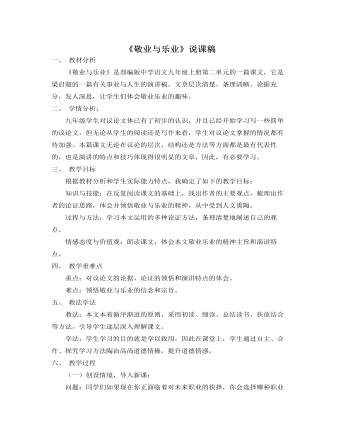
部编版语文九年级上册《敬业与乐业》说课稿
一、 教材分析《敬业与乐业》是部编版中学语文九年级上册第二单元的一篇课文,它是梁启超的一篇有关事业与人生的演讲稿。文章层次清楚、条理清晰、论据充分,发人深思,让学生们体会敬业乐业的趣味。二、 学情分析:九年级学生对议论文体已有了初步的认识,并且已经开始学习写一些简单的议论文。但无论从学生的阅读还是写作来看,学生对议论文掌握的情况都有待加强。本篇课文无论在议论的层次、结构还是方法等方面都是最有代表性的,也是演讲的特点和技巧体现得很明显的文章,因此,有必要学习。三、 教学目标根据教材分析和学生实际能力特点,我确定了如下的教学目标:知识与技能:在反复阅读课文的基础上,找出作者的主要观点,梳理出作者的论证思路,体会并领悟敬业与乐业的精神,从中受到人文熏陶。过程与方法:学习本文运用的多种论证方法,条理清楚地阐述自己的观点。
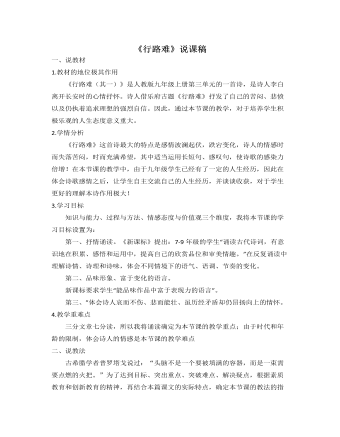
部编版语文九年级上册《行路难》说课稿
一、说教材1.教材的地位极其作用《行路难(其一)》是人教版九年级上册第三单元的一首诗,是诗人李白离开长安时的心情抒怀。诗人借乐府古题《行路难》抒发了自己的苦闷、悲愤以及仍执着追求理想的强烈自信。因此,通过本节课的教学,对于培养学生积极乐观的人生态度意义重大。2.学情分析《行路难》这首诗最大的特点是感情波澜起伏,跌宕变化,诗人的情感时而失落苦闷,时而充满希望,其中适当运用长短句、感叹句,使诗歌的感染力倍增!在本节课的教学中,由于九年级学生已经有了一定的人生经历,因此在体会诗歌感情之后,让学生自主交流自己的人生经历,并谈谈收获,对于学生更好的理解本诗作用极大!3.学习目标知识与能力、过程与方法、情感态度与价值观三个维度,我将本节课的学习目标设置为:
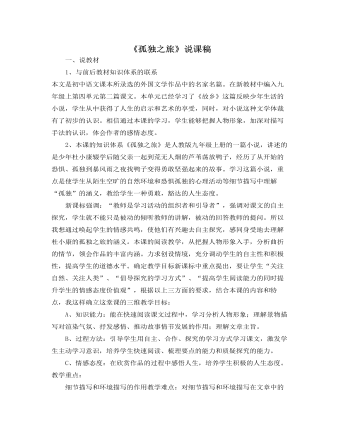
部编版语文九年级上册《孤独之旅》说课稿
二、说教法:我在设计这节课时努力实践新课程理念,充分突出学生的主体地位选择教学方法,整堂课以“在情节与现实写照中得到情感体验”为教学主线,通过整体感知,情节领悟,细节品味等途径,运用快速阅读,自主合作探究等方法,引导学生深入文本,感受主旨,与文章对话,与自己对话,与同学老师对话,在这种感受,体验、交流的课堂学习过程中逐步提升情感态度价值观。三、说学法:采用“自主、合作、探究”的学习方式,让学生自主进入文本,读出感受,通过小组合作交流探究来解决问题。【二·三理论依据】教学过程必须根据学生语文学习的特点,关注学生的个体的学习需求,爱护学生的好奇心,求知欲,充分激发学生的主动意识,倡导自主、合作、探究的学习方式,有助于学生学习方式的形成。
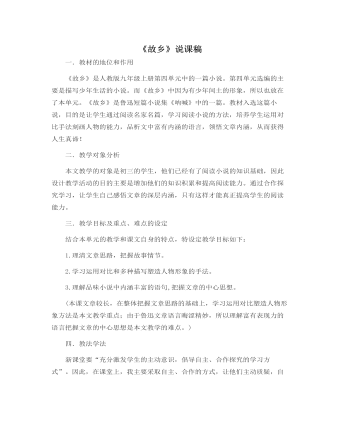
部编版语文九年级上册《故乡》说课稿
一.教材的地位和作用《故乡》是人教版九年级上册第四单元中的一篇小说。第四单元选编的主要是描写少年生活的小说。而《故乡》中因为有少年闰土的形象,所以也放在了本单元。《故乡》是鲁迅短篇小说集《呐喊》中的一篇。教材入选这篇小说,目的是让学生通过阅读名家名篇,学习阅读小说的方法,培养学生运用对比手法刻画人物的能力,品析文中富有内涵的语言,领悟文章内涵,从而获得人生真谛!二.教学对象分析本文教学的对象是初三的学生,他们已经有了阅读小说的知识基础,因此设计教学活动的目的主要是增加他们的知识积累和提高阅读能力。通过合作探究学习,让学生自己感悟文章的深层内涵,只有这样才能真正提高学生的阅读能力。三.教学目标及重点、难点的设定

部编版语文九年级上册《醉翁亭记》说课稿
1.创设情景法:利用多媒体课件,音乐、图片、文字相结合,激发学生学习兴趣和对本课的求知欲望,从而达到良好的教学效果。2.“自学——点拨——归纳”法:课前,教师根据教学目标设计出本课的“自学问题单”,让学生结合“自学问题单”先自学,预习课文;课堂上,小组合作讨论、解疑,教师适时点拨,最后归纳,逐步解决“自学问题单”中的问题,从而完成“教学目标”中的任务。四、说学法郭沫若先生曾说读书要“用自己的头脑来想,用自己的眼睛来看,用自己的手来做”。《语文课程标准》也特别强调:语文课程必须面向全体学生,使学生获得基本的语文素养,自主、合作、探究的学习方式应得到积极的提倡。九年级学生经过两年的初中学习后,已基本形成了一定的学习方法,也已经有了自主意识和自主学习的能力,所以,我采用了“自主、合作、探究”的学习方式。
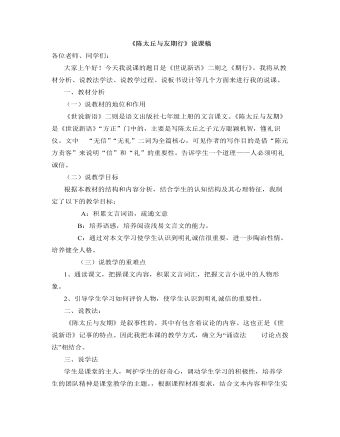
部编版语文七年级上册《陈太丘与友期行》说课稿
各位老师、同学们:大家上午好!今天我说课的题目是《世说新语》二则之《期行》。我将从教材分析、说教法学法、说教学过程、说板书设计等几个方面来进行我的说课。一、教材分析(一)说教材的地位和作用《世说新语》二则是语文出版社七年级上册的文言课文。《陈太丘与友期》是《世说新语》“方正”门中的,主要是写陈太丘之子元方聪颖机智,懂礼识仪。文中 “无信”“无礼”二词为全篇核心,可见作者的写作目的是借“陈元方责客”来说明“信”和“礼”的重要性。告诉学生一个道理——人必须明礼诚信。(二)说教学目标根据本教材的结构和内容分析,结合学生的认知结构及其心理特征,我制定了以下的教学目标:A:积累文言词语,疏通文意B:培养语感,培养阅读浅易文言文的能力。
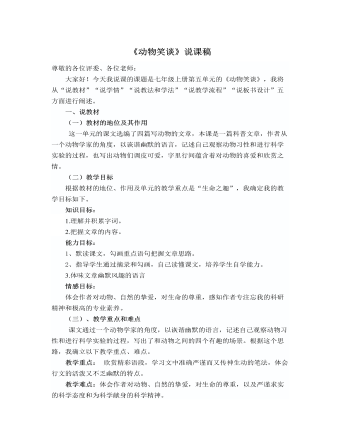
部编版语文七年级上册《动物笑谈》说课稿
(一)谈话激趣,导入新课好的开头是成功的一半,注重导入情节的创设,是兴趣激发的一个重点,也是创设学习氛围的重要环节。因此在导入新课时,我会用富有感染力的话语吸引学生,激发学生的学习兴趣。具体设计:同学们,在我们的地球上生活着大量的动物,走进它们,我们会发现世界是那么的多姿多彩,富有情趣。在这一点上,法国的法布尔做得很好,与他一样负有盛名的是奥地利的动物学家康拉德?劳伦兹,他曾经获得诺贝尔生理医学奖,今天就让我们走进他的《动物笑谈》,去看看他和动物之间有趣的故事吧!(二)初读课文,整体感知学生在预习的基础上将重点字音及成语解释在书上进行勾画和补充,进一步熟悉课文,并概括文章的主要内容。1.关于作者康拉德?劳伦兹(1903 -1989+,奥地利动物行为学家,1973年由于对动物行为学研究方面开拓性的成就而获诺贝尔生理医学奖,除了在学术上的成就之外,劳伦兹最为人所称道的是他在动物行为方面的通俗写作,著有《所罗门王的指环》《攻击的秘密》《雁语者》《狗的家世》等。
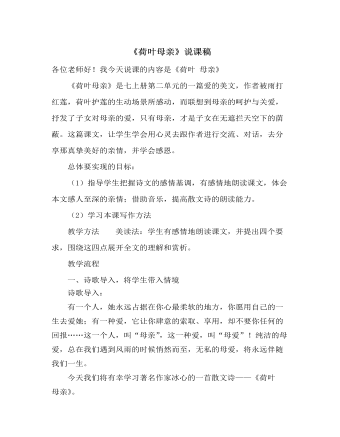
部编版语文七年级上册《荷叶·母亲》说课稿
各位老师好!我今天说课的内容是《荷叶 母亲》 《荷叶母亲》是七上册第二单元的一篇爱的美文,作者被雨打红莲,荷叶护莲的生动场景所感动,而联想到母亲的呵护与关爱,抒发了子女对母亲的爱,只有母亲,才是子女在无遮拦天空下的荫蔽。这篇课文,让学生学会用心灵去跟作者进行交流、对话,去分享那真挚美好的亲情,并学会感恩。总体要实现的目标: (1)指导学生把握诗文的感情基调,有感情地朗读课文,体会本文感人至深的亲情;借助音乐,提高散文诗的朗读能力。(2)学习本课写作方法教学方法 美读法:学生有感情地朗读课文,并提出四个要求,围绕这四点展开全文的理解和赏析。
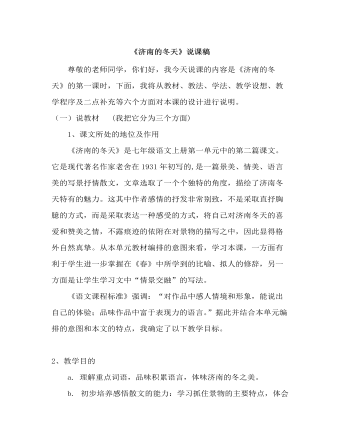
部编版语文七年级上册《济南的冬天》说课稿
这节课我是按“引入新课——讲授新课——反馈练习——归纳总结”进行教学的。 1、引入新课:我先对布置的预习作业进行抽查并明确生字词答案;然后以简洁的话语引入新课,情境导入一年有四季,季季有特色。今天我们单表一下多姿的冬天。和学生一起欣赏燕京一带冬天雪花,感受边塞冬天的奇寒;东北的冬天,云南的冬天。引出素有“泉城”之称的济南,冬天又是怎样的呢?今天,就让我们追逐老舍先生的足迹,到济南去看一下冬天的景象,感受一下冬天的气息。(这时用课件对作者及与课文有关的经历进行介绍) 2、讲授新课:在讲授前,让学生带着问题对课文进行朗读,使学生感知课文,问题用课件打出如下: a、为什么说济南是个“宝地”? b、济南是有山有水的地方,文中写了三幅山景图,还写了水色,各突出了什么特点 (抓关键词概括) ? 三幅山景图之间有什么关系? 四幅景物图你最喜欢哪一幅,为什么? c、文中渗透作者对济南的冬天什么样的感情?
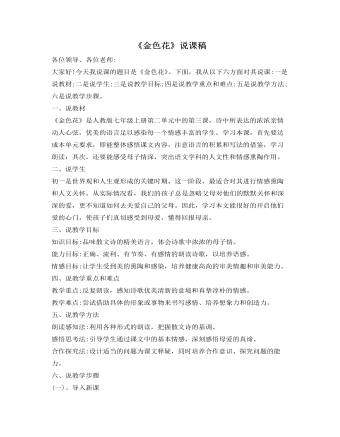
部编版语文七年级上册《金色花》说课稿
三、说教学目标知识目标:品味散文诗的精美语言,体会诗歌中浓浓的母子情。能力目标:正确、流利、有节奏、有感情的朗读诗歌,以培养语感。情感目标:让学生受到美的熏陶和感染,培养健康高尚的审美情趣和审美能力。四、说教学重点和难点教学重点:反复朗读,感知诗歌优美清新的意境和真挚淳朴的情感。教学难点:尝试借助具体的形象或事物来书写感情、培养想象力和创造力。五、说教学方法朗读感知法:利用各种形式的朗读,把握散文诗的基调。感悟思考法:引导学生通过课文中的基本情感,深刻感悟母爱的真谛。合作探究法:设计适当的问题为课文释疑,同时培养合作意识、探究问题的能力。六、说教学步骤(一)、导入新课课前播放满文军的《懂你》,音乐结束后,老师简洁引入:“有一种爱,一生一世不求回报,母爱;有一个人,一生一世值得我们去爱,母亲。今天,让我们走进泰戈尔的散文诗《金色花》,去感受那份纯洁的永恒的母爱吧!”
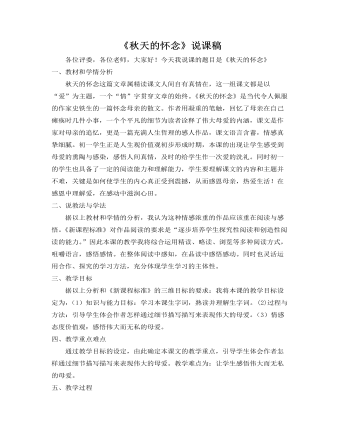
部编版语文七年级上册《秋天的怀念》说课稿
一、教材和学情分析秋天的怀念这篇文章属精读课文人间自有真情在,这一组课文都是以“爱”为主题,一个“情”字贯穿文章的始终。《秋天的怀念》是当代令人佩服的作家史铁生的一篇怀念母亲的散文。作者用凝重的笔触,回忆了母亲在自己瘫痪时几件小事,一个个平凡的细节为读者诠释了伟大母爱的内涵,课文是作家对母亲的追忆,更是一篇充满人生哲理的感人作品,课文语言含蓄,情感真挚细腻。初一学生正是人生观价值观初步形成时期,本课的出现让学生感受到母爱的熏陶与感染,感悟人间真情,及时的给学生作一次爱的洗礼。同时初一的学生也具备了一定的阅读能力和理解能力,学生要理解课文的内容和主题并不难,关键是如何使学生的内心真正受到震撼,从而感恩母亲,热爱生活!在感恩中理解爱,在感动中滋润心田。

